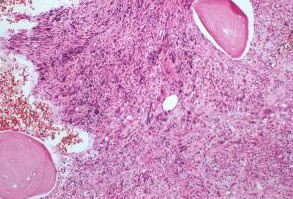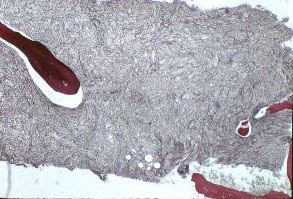Course Authors
Robert G. Lerner, M.D.
In the past three years, Dr. Lerner has served as a consultant for RPR, and has served on the Speakers' Bureau for Pharmacia & Upjohn.
Estimated course time: 1 hour(s).

Albert Einstein College of Medicine – Montefiore Medical Center designates this enduring material activity for a maximum of 1.0 AMA PRA Category 1 Credit(s)™. Physicians should claim only the credit commensurate with the extent of their participation in the activity.
In support of improving patient care, this activity has been planned and implemented by Albert Einstein College of Medicine-Montefiore Medical Center and InterMDnet. Albert Einstein College of Medicine – Montefiore Medical Center is jointly accredited by the Accreditation Council for Continuing Medical Education (ACCME), the Accreditation Council for Pharmacy Education (ACPE), and the American Nurses Credentialing Center (ANCC), to provide continuing education for the healthcare team.
Upon completion of this Cyberounds®, you should be able to:
The Case
A 52-year-old man recently was referred to me for further evaluation. About 20 years ago he was in an automobile accident and suffered a ruptured spleen requiring splenectomy. One year after recovering from surgery his hemoglobin rose to 17.3 gm % and his hematocrit rose to 58%. The white blood cell count was 14,700/mm3 and platelet count 1,000,030/mm3. An additional work-up at the time revealed an elevated leukocyte alkaline phosphatase and an elevated vitamin B12 level of 2238. A bone marrow aspiration was performed, revealing increased cellularity with normal appearing cells.
Polycythemia vera was suspected and a red blood cell mass determination was done, with a result of 40.5 ml/kg. He was treated with phlebotomy and busulfan, and eventually switched to hydroxyurea which was continued until March of 1996. At that time a moderate anemia was noted while his platelet count remained elevated. His only symptom was marked itching. A bone marrow examination still revealed hypercellularity with many megakaryocytes, and interferon was started at a dose of three million units subcutaneously three times weekly. Over the next several months the anemia worsened requiring multiple transfusions. A repeat bone marrow aspiration was attempted but a specimen could not be aspirated. A needle biopsy specimen now revealed marked fibrosis. Figure 1 shows a standard H&E section of his bone marrow:
Figure 1.

Figure 2 shows a trichrome stain which accentuates the fibrosis by staining it blue:

Discussion
Polycythemia vera, also called polycythemia rubra vera, is a disease characterized by an over production of red blood cells usually also with an over production of granulocytes and platelets. In the typical patient, the disease first becomes obvious in middle to older age. It may be detected by an abnormal blood count or splenomegaly noted on routine screening or because of the development of thrombosis or symptoms of headache, itching, weakness, dizziness or sweating. Often, all the typical manifestations of erythrocytosis, leukocytosis, thrombocytosis and splenomegaly are present without any manifestations of other illnesses so that the diagnosis can be made with certainty without any other intervention. Other times, the differential diagnosis must be made between polycythemia vera, secondary polycythemia, spurious polycythemia and "primary familial and congenital" polycythemia.
In normal people, erythroid colonies can be grown in vitro from peripheral blood cells if erythropoietin is added to stimulate growth. However, in patients with polycythemia vera, the red cell precursors grow independently of erythropoietin stimulation.(2) This characteristic has led to the suggestion that growing erythroid colonies in vitro from peripheral blood be used as a simple one step diagnostic test for polycythemia vera. This fit well with the concept that the disease was characterized by unregulated growth of red blood cell precursors. However, newer culture methods have allowed erythroid colonies to be grown in a culture medium which is devoid of all serum and thus uncontaminated by growth factors present in serum. It now appears that the erythroid precursors do not grow on their own any more than normal, but are actually hyperresponsive to insulin-like growth factor-I.(3)
In an abstract just presented at the American Society of Hematology meetings it was reported that megakaryocytic progenitors of polycythemia vera patients are hypersensitive to thrombopoietin.(4) The presumed mutation that leads to this disorder remains unknown, even though many patients have a karyotypic abnormality. As the disease progresses, fibroblasts proliferate in the marrow even though they are not part of the malignant clone. This may be in response to fibroblast growth factor from the megakaryocytes. There is some evidence that suppressing the megakaryocyte proliferation with chemotherapy may delay the onset of fibrosis.(5)
New information on what is now called "primary familial and congenital polycythemia" suggests that there is a heterogeneous group of diseases in which no cause for secondary polycythemia exists.(6) They appear to develop from mutations affecting the erythropoietin receptor gene, the erythropoietin gene or possibly genes for accessory proteins related to the control of erythropoiesis. Thrombotic complications such as stroke, myocardial infarction, deep vein thrombosis, pulmonary embolism and hepatic vein thrombosis are frequent, and aspirin is not adequate to prevent them.(7)
Myelosuppressive therapy will decrease the frequency of thrombosis. Despite the thrombotic tendency a hemostatic defect is also present with frequent bruising and bleeding with surgery. Intense pruritis, poorly responsive to antihistamines, is a frequent problem. Secondary gout can also occur.
Diagnosis
When a diagnosis has to be established, the Polycythemia Vera Study Group has suggested that the first step should be a determination of the red cell mass to verify that it is increased and that one is not dealing with spurious polycythemia secondary to a decreased plasma volume. (The Polycythemia Vera Study Group published an update in a series of articles in the Seminars in Hematology issues of April and July 1996.(8) However, such cases usually have only a mild elevation of hematocrit without any leukocytosis, thrombocytosis or splenomegaly and the direct determination of the red cell mass is itself prone to inaccuracy leaving one uncertain in such cases. A true elevation of the red blood cell mass is seen in secondary polycythemia due to erythropoietin produced secondary to hypoxia or by a neoplasm.
Hypoxia may be secondary to a congenital abnormality of hemoglobin which has such high affinity for oxygen that it is not released to the tissues. This is familial of course but is different from the primary familial and congenital polycythemias. Work up should include a determination of oxygen saturation and a search for causes of secondary polycythemia, especially when leukocytosis, thrombocytosis and splenomegaly are not present. As mentioned earlier, in vitro growth of erythroid colonies without erythropoietin has been suggested as a diagnostic test, but this is often not practical because a specialized laboratory is not available. It has also not been well established and may not even be valid in light of the new information obtained from colony growth in truly serum free conditions referred to above.
Treatment
During the plethoric phase of the illness which may last years, therapy is indicated, even with minimal symptoms, to decrease the risk of thrombosis. Phlebotomy alone is easy and may be suitable for young individuals without thrombotic problems. However, it does not correct thrombocytosis and may be associated with earlier myelofibrosis. This may be balanced by a lower likelihood of leukemia when compared to myelosuppressive therapy. Hydroxyurea has become the myelosuppressive agent of choice because of its easy reversibility and apparent lower leukemogenic potential compared to busulfan or radioactive phosphorus (32P). The combination of hydroxyurea and phlebotomy is now the most widely accepted therapy. Interferon has been used and may decrease splenomegaly but its long term advantages or disadvantages have not yet been clearly established.
When myelofibrosis, leukemia or myelodysplasia develop as part of the evolution of polycythemia vera, they tend to respond less well to therapy than when they develop de novo. Thus the prognosis for the patient described above is unclear. At this time he has just been started on erythropoietin injections as a therapeutic trial to see if this will increase his hemoglobin level to the point that he no longer requires transfusion. Even though his own erythropoietin level is normal this may be successful if his own level is less than 500.